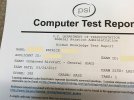I found the Title 14, Chapter I, Subchapter F, Part 107 page on the FAA web site and it produced a 25 page PDF -- which is far less than I expected. I figured it would be hundreds if not thousands of pages. I assume if I read it and comprehended it, I could pass the exam.
Or... I could take a course. I see that Pilot Institute has a lot of supports here on the site and I've read a lot of positive reasons to go that route.
And this site has a couple of links to other courses. All of them seem roughly the same price range. Given what I've seen so far, the Pilot Institute seems most likely the best option.
There is a small squabble on this site about being able to learn all this on your own via FAA documents and free YouTube videos.
In my case, I've vaguely toyed with drones since 2015 starting with an Inspire 1. I now have a Mavic 3 Cine. Eyeing the new Avata -- that looks super fun. Recently retired and I do a lot of photography with vague hopes of making a small income from it. Mostly I don't want to get harassed by Uncle Sam.
So... mostly this post is just to verify that all of the above is "correct" (give or take) and I'm not totally off the rails.
Or... I could take a course. I see that Pilot Institute has a lot of supports here on the site and I've read a lot of positive reasons to go that route.
And this site has a couple of links to other courses. All of them seem roughly the same price range. Given what I've seen so far, the Pilot Institute seems most likely the best option.
There is a small squabble on this site about being able to learn all this on your own via FAA documents and free YouTube videos.
In my case, I've vaguely toyed with drones since 2015 starting with an Inspire 1. I now have a Mavic 3 Cine. Eyeing the new Avata -- that looks super fun. Recently retired and I do a lot of photography with vague hopes of making a small income from it. Mostly I don't want to get harassed by Uncle Sam.
So... mostly this post is just to verify that all of the above is "correct" (give or take) and I'm not totally off the rails.













